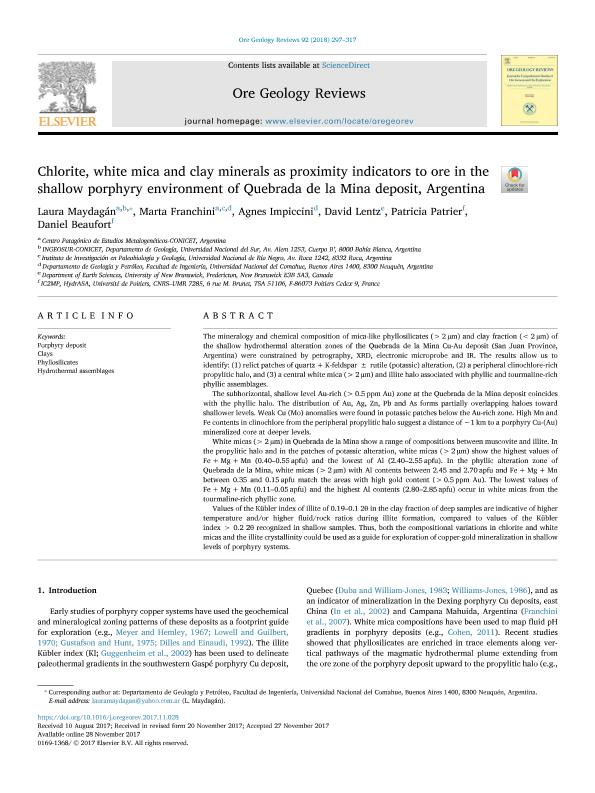Artículo
Chlorite, white mica and clay minerals as proximity indicators to ore in the shallow porphyry environment of Quebrada de la Mina deposit, Argentina
Maydagán, Laura ; Franchini, Marta Beatriz
; Franchini, Marta Beatriz ; Impiccini, Agnes; Lentz, David; Patrier, Patricia; Beaufort, Daniel
; Impiccini, Agnes; Lentz, David; Patrier, Patricia; Beaufort, Daniel
 ; Franchini, Marta Beatriz
; Franchini, Marta Beatriz ; Impiccini, Agnes; Lentz, David; Patrier, Patricia; Beaufort, Daniel
; Impiccini, Agnes; Lentz, David; Patrier, Patricia; Beaufort, Daniel
Fecha de publicación:
01/2018
Editorial:
Elsevier Science
Revista:
Ore Geology Reviews
ISSN:
0169-1368
Idioma:
Inglés
Tipo de recurso:
Artículo publicado
Clasificación temática:
Resumen
The mineralogy and chemical composition of mica-like phyllosilicates (>2 µm) and clay fraction (<2 µm) of the shallow hydrothermal alteration zones of the Quebrada de la Mina Cu-Au deposit (San Juan Province, Argentina) were constrained by petrography, XRD, electronic microprobe and IR. The results allow us to identify: (1) relict patches of quartz + K-feldspar ± rutile (potassic) alteration, (2) a peripheral clinochlore-rich propylitic halo, and (3) a central white mica (>2 µm) and illite halo associated with phyllic and tourmaline-rich phyllic assemblages. The subhorizontal, shallow level Au-rich (>0.5 ppm Au) zone at the Quebrada de la Mina deposit coincides with the phyllic halo. The distribution of Au, Ag, Zn, Pb and As forms partially overlapping haloes toward shallower levels. Weak Cu (Mo) anomalies were found in potassic patches below the Au-rich zone. High Mn and Fe contents in clinochlore from the peripheral propylitic halo suggest a distance of ∼1 km to a porphyry Cu-(Au) mineralized core at deeper levels. White micas (>2 µm) in Quebrada de la Mina show a range of compositions between muscovite and illite. In the propylitic halo and in the patches of potassic alteration, white micas (>2 µm) show the highest values of Fe + Mg + Mn (0.40–0.55 apfu) and the lowest of Al (2.40–2.55 apfu). In the phyllic alteration zone of Quebrada de la Mina, white micas (>2 µm) with Al contents between 2.45 and 2.70 apfu and Fe + Mg + Mn between 0.35 and 0.15 apfu match the areas with high gold content (>0.5 ppm Au). The lowest values of Fe + Mg + Mn (0.11–0.05 apfu) and the highest Al contents (2.80–2.85 apfu) occur in white micas from the tourmaline-rich phyllic zone. Values of the Kübler index of illite of 0.19–0.1 2θ in the clay fraction of deep samples are indicative of higher temperature and/or higher fluid/rock ratios during illite formation, compared to values of the Kübler index > 0.2 2θ recognized in shallow samples. Thus, both the compositional variations in chlorite and white micas and the illite crystallinity could be used as a guide for exploration of copper-gold mineralization in shallow levels of porphyry systems.
Palabras clave:
Clays
,
Hydrothermal Assemblages
,
Phyllosilicates
,
Porphyry Deposit
Archivos asociados
Licencia
Identificadores
Colecciones
Articulos(CCT - PATAGONIA NORTE)
Articulos de CTRO.CIENTIFICO TECNOL.CONICET - PATAGONIA NORTE
Articulos de CTRO.CIENTIFICO TECNOL.CONICET - PATAGONIA NORTE
Articulos(INGEOSUR)
Articulos de INST.GEOLOGICO DEL SUR
Articulos de INST.GEOLOGICO DEL SUR
Citación
Maydagán, Laura; Franchini, Marta Beatriz; Impiccini, Agnes; Lentz, David; Patrier, Patricia; et al.; Chlorite, white mica and clay minerals as proximity indicators to ore in the shallow porphyry environment of Quebrada de la Mina deposit, Argentina; Elsevier Science; Ore Geology Reviews; 92; 1-2018; 297-317
Compartir
Altmétricas



